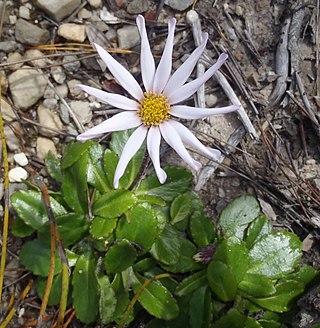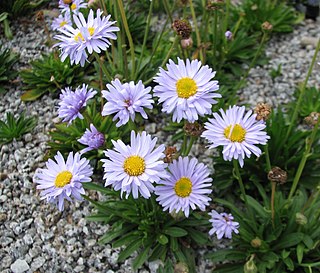
The family Asteraceae, alternatively Compositae, consists of over 32,000 known species of flowering plants in over 1,900 genera within the order Asterales. Commonly referred to as the aster, daisy, composite, or sunflower family, Compositae were first described in the year 1740. The number of species in Asteraceae is rivaled only by the Orchidaceae, and which is the larger family is unclear as the quantity of extant species in each family is unknown.

Aster is a genus of perennial flowering plants in the family Asteraceae. Its circumscription has been narrowed, and it now encompasses around 170 species, all but one of which are restricted to Eurasia; many species formerly in Aster are now in other genera of the tribe Astereae. Aster amellus is the type species of the genus and the family Asteraceae.

Ionactis, common name stiff-leaved asters or ankle-asters, is a small genus of plants belonging to the family Asteraceae. These aster-like plants are endemic to North America. One species is widespread across much of the eastern half of the continent, while two others are rare endemics with very restricted ranges.

Mairia is a genus of perennial herbaceous plants assigned to the family Asteraceae. All species have leathery, entire or toothed leaves in rosettes, directly from the underground rootstock, and one or few flower heads sit at the top of the stems that carry few bracts. These have a whorl of white to mauve ray florets surrounding yellow disc florets in the centre. In general, flowering only occurs after the vegetation has burned down. The six species currently assigned to Mairia are endemic to the Western Cape and Eastern Cape provinces of South Africa. Some of the species are called fire daisy in English and vuuraster in Afrikaans.

Olearia tomentosa, commonly known as the toothed daisy-bush, is a species of flowering plant in the family Asteraceae and is endemic to south-eastern continental Australia. It is a spreading shrub with egg-shaped leaves, the edges toothed or lobed, and blue or white and yellow, daisy-like inflorescences.

Brachyscome multifida is a perennial herb in the family Asteraceae. Common names include cut-leaved daisy, rocky daisy, and Hawkesbury daisy. The species is endemic to Australia.

Olearia covenyi is a species of flowering plant in the family Asteraceae and is endemic to New South Wales. It is a shrub with scattered egg-shaped leaves, and white and yellow, daisy-like inflorescences.

Olearia astroloba, commonly known as marble daisy-bush, is a species of flowering plant in the family Asteraceae and is endemic to a restricted area of Victoria in Australia. It is a greyish shrub with sessile, spatula-shaped leaves and mauve or violet and purple, daisy-like inflorescences.

Olearia suffruticosa, commonly known as clustered daisy-bush, is a species of flowering plant in the family Asteraceae and is endemic to south-eastern continental Australia. It is a shrub or undershrub with scattered, linear, grass-like leaves and pink to white and yellow and pink, daisy-like inflorescences.

Brachyscome scapigera, commonly known as tufted daisy, is a perennial herb in the family Asteraceae. The species is endemic to south-eastern Australia.

Brachyscome segmentosa, commonly known as the Lord Howe Island daisy or mountain daisy, is a herb in the family Asteraceae. The specific epithet comes from the Latin segmentum ("segment") with the suffix -osa, alluding to the many deep divisions of the leaf.

Brachyscome ascendens, the border ranges daisy, is a species of flowering plant in the family Asteraceae and is endemic to Australia. It has mostly mauve daisy-like flowers and a yellow centre.
Olearia burgessii is a species of flowering plant in the family Asteraceae and is endemic to south-eastern New South Wales. It is a shrub with scattered elliptic to egg-shaped leaves with the narrower end towards the base, and white and yellow, daisy-like inflorescences.
Olearia curticoma is a species of flowering plant in the family Asteraceae and is endemic to Victoria. It is an erect shrub with glabrous, sticky branchlets, linear leaves and white and yellow, daisy-like inflorescences.
Olearia eremaea is a species of flowering plant in the family Asteraceae and is endemic to inland areas of Western Australia. It is a shrub with scattered, more or less elliptic leaves, and white and yellow, daisy-like inflorescences.
Olearia incana is a species of flowering plant in the family Asteraceae and is endemic to southern Australia. It is a shrub with narrowly elliptic or wedge-shaped leaves and white and pale yellow, daisy-like inflorescences.

Olearia passerinoides, commonly known as slender daisy bush, is a species of flowering plant in the family Asteraceae and is endemic to southern continental Australia. It is a slender, sticky shrub with linear leaves, and white or pale mauve and mauve or pink daisy flowers.

Brachyscome bellidioides is a species of flowering plant in the family Asteraceae and is endemic to the southwest of Western Australia. It is an annual herb with linear leaves and yellow and white daisy-like flowers.

Brachyscome spathulata, commonly known as spoon-leaved daisy, is a flowering plant in the family Asteraceae. It has dark green leaves, mauve daisy-like flowers and grows in New South Wales, Tasmania, Victoria and the Australian Capital Territory.

Brachyscome mittagongensis, is a flowering plant in the family Asteraceae and is endemic to New South Wales. It has white daisy-like flowers and a yellow centre.
















